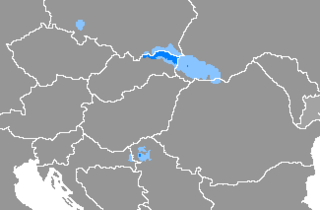
Back Rusyn Afrikaans اللغة الروسينية Arabic الروسينيه ARZ Idioma rusín AST Rusinava AVK Rusin dili Azerbaijani روسین دیلی AZB Rosienu kalba BAT-SMG Русінская мова Byelorussian Русінская мова BE-X-OLD
| Rusyn | |
|---|---|
| русинськый язык; руски язик rusîns'kyj jazyk; ruski jazik | |
| Ethnicity | Rusyns |
Native speakers | 70,000 (2001–2013)[1] Slovakia – 38,679[2] Serbia – 15,626[3] Poland – 10,000[4] Ukraine – 6,725[5] Croatia – 2,337[6] Hungary – 1,113[7] Czech Republic – 777[8] |
Early forms | |
| Dialects | |
| Cyrillic script (Rusyn alphabets) Latin script (Slovakia)[11] | |
| Official status | |
Official language in | |
Recognised minority language in | |
| Language codes | |
| ISO 639-3 | rue |
| Glottolog | rusy1239 |
| Linguasphere | 53-AAA-ec < 53-AAA-e |
 | |
 Rusyn is classified as Vulnerable by the UNESCO Atlas of the World's Languages in Danger [citation needed] | |
Rusyn (/ˈruːsɪn/ ROO-sin;[16] Carpathian Rusyn: русиньскый язык, romanized: rusîn'skyj jazyk; Pannonian Rusyn: руски язик, romanized: ruski jazik)[17][18] is an East Slavic language spoken by Rusyns in parts of Central and Eastern Europe, and written in the Cyrillic script.[19] The majority of speakers live in an area known as Carpathian Ruthenia that spans from Transcarpathia, westward into eastern Slovakia and south-east Poland.[20] There is also a sizeable Pannonian Rusyn linguistic island in Vojvodina, Serbia,[20] as well as a Rusyn diaspora throughout the world.[21][22] Per the European Charter for Regional or Minority Languages, Rusyn is officially recognized as a protected minority language by Bosnia and Herzegovina, Croatia, Hungary, Romania, Poland (as Lemko), Serbia, and Slovakia.[12]
The categorization of Rusyn as a language or dialect is a source of controversy.[23] Czech, Slovak, and Hungarian, as well as American and some Polish and Serbian linguists treat it as a distinct language[24][needs update] (with its own ISO 639-3 code), whereas other scholars (in Ukraine, Poland, Serbia, and Romania) treat it as a dialect of Ukrainian.[25][needs update]
- ^ Rusyn at Ethnologue (25th ed., 2022)

- ^ "Number of population by mother tongue in the Slovak Republic at 1. 1. 2021". Statistical Office of the Slovak Republic. Archived from the original on 21 January 2022. Retrieved 21 January 2022.
- ^ Republic of Serbia, Republic Statistical Office (24 December 2002). "Final results of the census 2002" (PDF). Archived from the original (PDF) on 6 March 2009. Retrieved 16 December 2010.
- ^ "Home" (PDF). Central Statistical Office of Poland. Archived from the original (PDF) on 16 January 2013. Retrieved 22 March 2012.
- ^ State Statistics Committee of Ukraine. "About number and composition population of UKRAINE by data All-Ukrainian population census 2001 data". Archived from the original on 2 March 2008. Retrieved 16 December 2010.
- ^ "Republic of Croatia – Central Bureau of Statistics". Crostat. Archived from the original on 27 May 2006. Retrieved 5 September 2010.
- ^ "1.28 Population by mother tongue, nationality and sex, 1900–2001". Hungarian Central Statistical Office. 2001. Archived from the original on 20 November 2012. Retrieved 28 February 2012.
- ^ "Obyvatelstvo podle věku, mateřského jazyka a pohlaví". Archived from the original on 27 June 2015. Retrieved 2 November 2012.
- ^ Biggam, Carole P. (2022). A Cultural History of Color in the Medieval Age. London: Bloomsbury Publishing Plc. p. 124. ISBN 9781350193499.
- ^ a b c Pugh 2009, p. vii.
- ^ Rusyn at Ethnologue (21st ed., 2018)

- ^ a b c d e f g h i Council of Europe 2021.
- ^ "The Statue of the Autonomous Province of Vojvodina, Serbia". Skupstinavojvodine.gov.rs. Archived from the original on 3 March 2012. Retrieved 7 August 2012.
- ^ "Implementation of the Charter in Hungary". Database for the European Charter for Regional or Minority Languages. Public Foundation for European Comparative Minority Research. Archived from the original on 27 February 2014. Retrieved 16 June 2014.
- ^ "I Raport dla Sekretarza Rady Europy z realizacji przez Rzeczpospolitą Polską postanowień Europejskiej karty języków regionalnych lub mniejszościowych" (PDF). Archived from the original (PDF) on 1 July 2014. Retrieved 28 April 2019.
- ^ "Home : Oxford English Dictionary". www.oed.com. Archived from the original on 17 April 2021. Retrieved 20 February 2021.
- ^ http://theses.gla.ac.uk/2781/1/2011BaptieMPhil-1.pdf Archived 23 May 2018 at the Wayback Machine, p. 8.
- ^ Plishkova 2009, p. 17, 37, 67.
- ^ Pugh 2009, p. 7.
- ^ a b Pugh 2009, p. 3.
- ^ Magocsi & Pop 2005, p. 267-281.
- ^ Kushko 2007, p. 111-132.
- ^ Moser 2016, p. 124-139.
- ^ Bernard Comrie, "Slavic Languages," International Encyclopedia of Linguistics (1992, Oxford, Vol 3), pp. 452–456.
Ethnologue, 16th edition - ^ George Y. Shevelov, "Ukrainian," The Slavonic Languages, ed. Bernard Comrie and Greville G. Corbett (1993, Routledge), pp. 947–998.
© MMXXIII Rich X Search. We shall prevail. All rights reserved. Rich X Search